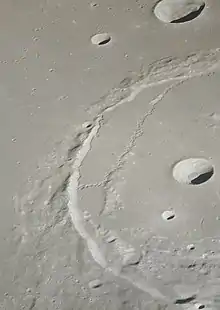Posidonius (crater)
Posidonius is a lunar impact crater that is located on the north-eastern edge of Mare Serenitatis, to the south of Lacus Somniorum. It was named after ancient Greek philosopher and geographer Posidonius of Apamea.[1] The crater Chacornac is attached to the southeast rim, and to the north is Daniell.


.png.webp) Mosaic of Lunar Reconnaissance Orbiter images | |
| Coordinates | 31.88°N 29.99°E |
|---|---|
| Diameter | 95 km |
| Depth | 2.3 km |
| Colongitude | 343° at sunrise |
| Eponym | Posidonius |

_1.png.webp)
Description
The rim of Posidonius is shallow and obscured, especially on the western edge, and the interior has been overlain by a lava flow in the past. The crater ramparts can still be observed to the south and east of the crater rim, and to a lesser degree to the north.
There is a smaller, semi-circular rim of a concentric, flooded crater within the main rim, offset towards the eastern edge. There is no central peak, but the floor is hilly and laced with a rille system named the Rimae Posidonius. The floor is also slightly bulged due to the past lava uplift, which also likely produced the complex of rilles. The northeast rim is interrupted by the smaller crater Posidonius B. Within the crater rim, offset just to the west of center is another smaller crater Posidonius A.
On the Mare Serenitatis surface near Posidonius is a notable system of wrinkle ridges that parallel the nearby shore. These are designated the Dorsa Smirnov. At the peak of these ridges is a small craterlet (Posidonius Y) with a diameter of 2 km. This craterlet is surrounded by a patch of high-albedo material, and is an example of a lunar bright spot. This peak was formerly designated Posidonius Gamma (γ).
Posidonius Gamma was first observed by the lunar cartographer Julius Schmidt in 1867, who noted the similarity to the bright patch surrounding the crater Linné.[2]
Satellite craters
By convention these features are identified on lunar maps by placing the letter on the side of the crater midpoint that is closest to Posidonius.
| Posidonius | Coordinates | Diameter, km |
|---|---|---|
| A | 31.69°N 29.52°E | 11.1 |
| B | 33.16°N 31.02°E | 14.1 |
| C | 31.13°N 29.69°E | 3.5 |
| E | 30.55°N 19.7°E | 3.1 |
| F | 32.82°N 27.13°E | 6.0 |
| G | 34.79°N 27.23°E | 4.8 |
| J | 33.8°N 30.79°E | 22.0 |
| M | 34.36°N 30.01°E | 9.3 |
| N | 29.7°N 21.04°E | 6.2 |
| P | 33.6°N 27.58°E | 14.7 |
| W | 31.65°N 20.13°E | 3.0 |
| Y | 30.03°N 24.91°E | 2.0 |
| Z | 30.75°N 22.95°E | 5.9 |
References
- "Posidonius (crater)". Gazetteer of Planetary Nomenclature. USGS Astrogeology Research Program.
- Elger T. G. (1895). The Moon. A Full Description and Map of its Principal Physical Features. London: Georg Philip & Son. p. 160. (In this book, east on the Moon is called "west" according to terminology of that time).
- Andersson, L. E.; Whitaker, E. A. (1982). NASA Catalogue of Lunar Nomenclature. NASA RP-1097.
- Bussey, B.; Spudis, P. (2004). The Clementine Atlas of the Moon. New York: Cambridge University Press. ISBN 978-0-521-81528-4.
- Cocks, Elijah E.; Cocks, Josiah C. (1995). Who's Who on the Moon: A Biographical Dictionary of Lunar Nomenclature. Tudor Publishers. ISBN 978-0-936389-27-1.
- McDowell, Jonathan (July 15, 2007). "Lunar Nomenclature". Jonathan's Space Report. Retrieved 2007-10-24.
- Menzel, D. H.; Minnaert, M.; Levin, B.; Dollfus, A.; Bell, B. (1971). "Report on Lunar Nomenclature by the Working Group of Commission 17 of the IAU". Space Science Reviews. 12 (2): 136–186. Bibcode:1971SSRv...12..136M. doi:10.1007/BF00171763.
- Moore, Patrick (2001). On the Moon. Sterling Publishing Co. ISBN 978-0-304-35469-6.
- Price, Fred W. (1988). The Moon Observer's Handbook. Cambridge University Press. ISBN 978-0-521-33500-3.
- Rükl, Antonín (1990). Atlas of the Moon. Kalmbach Books. ISBN 978-0-913135-17-4.
- Webb, Rev. T. W. (1962). Celestial Objects for Common Telescopes (6th revised ed.). Dover. ISBN 978-0-486-20917-3.
- Whitaker, Ewen A. (1999). Mapping and Naming the Moon. Cambridge University Press. ISBN 978-0-521-62248-6.
- Wlasuk, Peter T. (2000). Observing the Moon. Springer. ISBN 978-1-85233-193-1.
External links
| Wikimedia Commons has media related to Posidonius (crater). |
- Lunar Reconnaissance Orbiter pages with images:
- Plescia J. (2013-02-05). "Meanders in Posidonius". NASA/GSFC/LROC, School of Earth and Space Exploration, Arizona State University. Archived from the original on 2018-01-30. - especially on the rille Rimae Posidonius
- Braden S. (2011-10-25). "Posidonius Y". NASA/GSFC/LROC, School of Earth and Space Exploration, Arizona State University. Archived from the original on 2017-10-05.
- Ostrach L. (2010-12-01). "Rimae Posidonius". NASA/GSFC/LROC, School of Earth and Space Exploration, Arizona State University. Archived from the original on 2018-05-31.